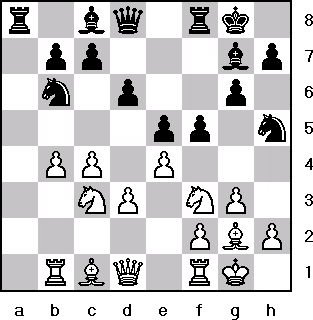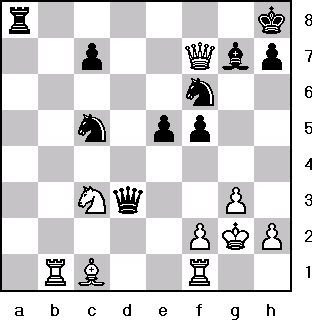|
Lesson
#10
How To Build An
Attack
We hear that calculating moves is very important in chess. This is especially
important when you are building an attack. So, what kinds of moves does the
attacking player make? I find that there are four kinds. And, the way you put
these four kinds of moves together often determines if your attack will fizzle
out or blaze ahead.
The player that is attacking is said to have the initiative. He
"initiates" the action. He does this with Preps, Threats, Combos and
Collects.
Prep — Many chess moves are simply preparation. They prepare you for
making better moves later. Natural exchange of material are preps. Many
developing moves in the opening are also "preps".
Threat — A threat is an attack on something valuable to your opponent.
This could be a piece, his king safety, his pawn structure, etc. Threats are
important because the defender usually has to answer the threat. This limits the
defenderís options while the attacker has lots of choices.
Combo — In its simplest form a combo (or combination) is a double
threat. For this reason, combos are harder to meet than a single threat. Often,
a simple combo will force the win of material.
Collect — After your combo is successful or if your opponent ignores
your threat you can "collect" some material. When you do this you need
to be careful because you are moving a piece to a square that might not be a
good one. As a result, you may lose the initiative. I call this "cashing
in".
Here is a game I played (as white) against Larry Christiansen when we were
both teenagers. Larry went on to become a International Grandmaster and a U.S.
Champion.
1. c4 Nf6 2. g3 g6 3. Bg2 Bg7 4. Nf3 0-0 5. 0-0 d6 6. Nc3 Nbd7 7. Rb1 e5 8.
b4 Nh5 9. e4 a5 10. a3 Nb6 11. d3 axb4 12. axb4 f5
|

|
|
White to move
|
Larry has played aggressively and has hopes of a kingside attack with 13. ...
f4. But I proceeded to use threats to build a strong initiative.
13. exf5 (Prep, opens the long diagonal) gxf5
14 Ng5 (Threat on the knight on h5) Nf6
15. c5! (Threat and opens a2-g8 diagonal) dxc5
16. Qb3+ (Threat, develops queen) Kh8
Now I could play the 17. Nf7+ combo (forking king and queen) but after 17.
... Rxf7 18. Qxf7 I would have "collected" the exchange but lost the
initiative. I played for more. Sometimes itís better to keep the threat in
your pocket instead of cashing it in for material.
17. bxc5 (Combo, now Iíve got two threats) Nbd7
18. c6! (Combo, now with three threats!) Nc5
Notice that the black knight goes to c5 but does not get to collect the pawn
there. Now Larry has set a trap. If 19. Nf7+ Rxf7 20. Qxf7 Be6 traps my queen.
But, I add more threats and divert his bishop.
19. cxb7! (Combo - 3 threats vs. blackís one) Bxb7
20. Nf7+ (Combo at last) Rxf7
21. Qxf7 (Collect, the queen is happy here) Bxg2
22. Kxg2 (Prep, typical after a collect) Qxd3
Now black appears to be attacking and white must defend the knight on c3. Or
do I? This is the critical point in the game. How does white continue to make
threats?
|

|
|
White to move
|
23. Bh6! (Threat, bigger than blackís) Ne8. If black tried 23Ö
Bxh6 then 24. Qxf6+ Bg7 25. Qc6 and whiteís combo wins a piece.
24. Bxg7+ (Threat, checks threaten royalty) Nxg7
25. Qxc7 (Combo, two threats vs. one) Nce6
26. Rb8+ (Threat, keeps the attack going) Rxb8
27. Qxb8+ (Yet another threat) Qd8
The black queen never got to take the white knight on c3. Whiteís threats
were simply too powerful and had to be answered.
28. Rb1 (Prep, gets the rook in the game) h6
29. Qxe5 (Threatens 30. Rb8) Kh7
30. Rb8 (Threat, clears the bank rank) Qd3
- Rb7
(Threatens the knight at e6) Black Resigns
Here is a tally of the last 19 moves by white:
Prep 3 times
Threat 10 times
Combo 5 times
Collect 1 time
The threats just kept coming. I didnít cash in too quickly but waited until
the right time to collect. That way I didnít lose the initiative.
May you have many strong attacks filled with threats and combos. Just donít
collect too soon.
Home Page ∑
More Lessons
(c) 2001 Ross Stoutenborough
|